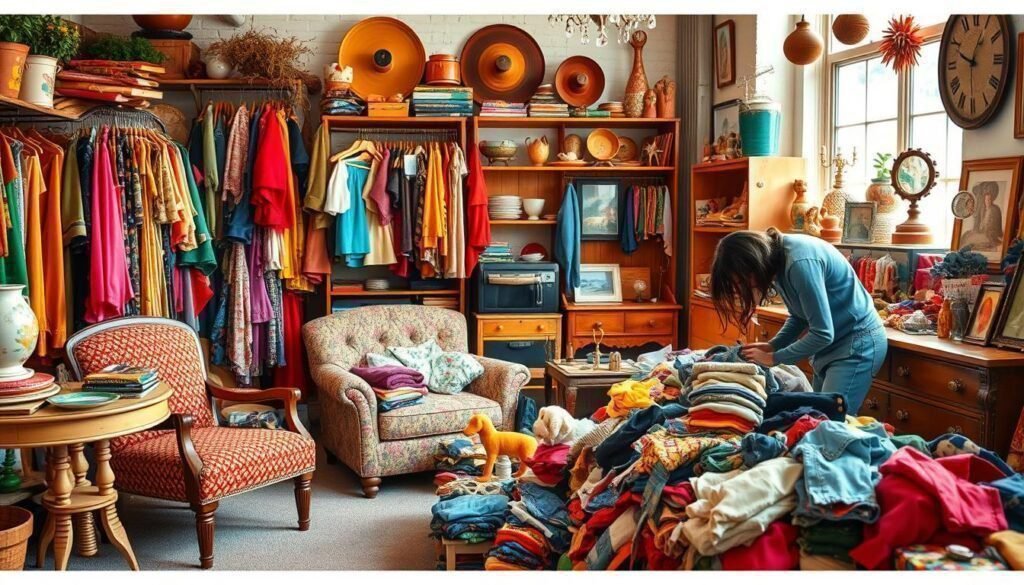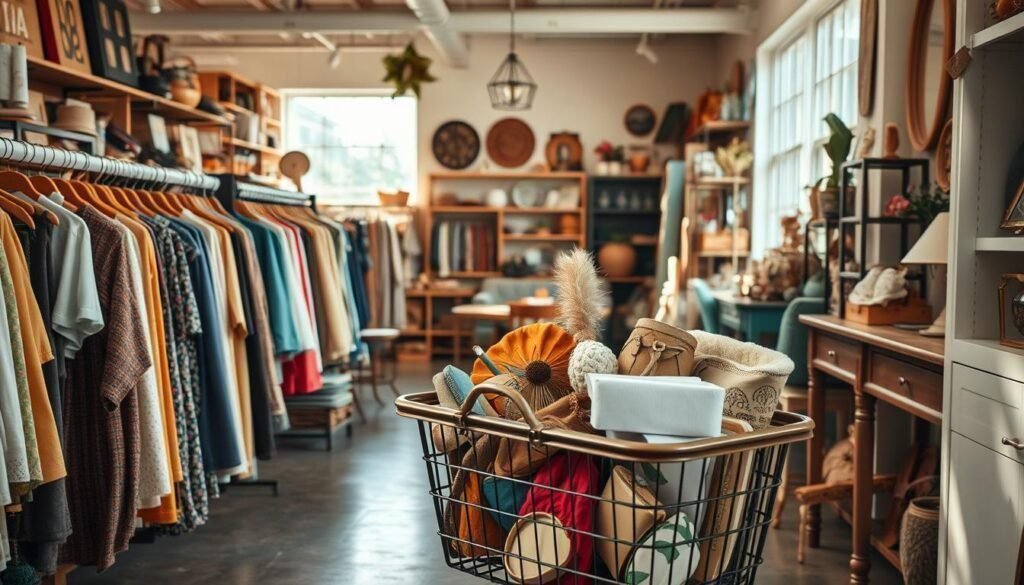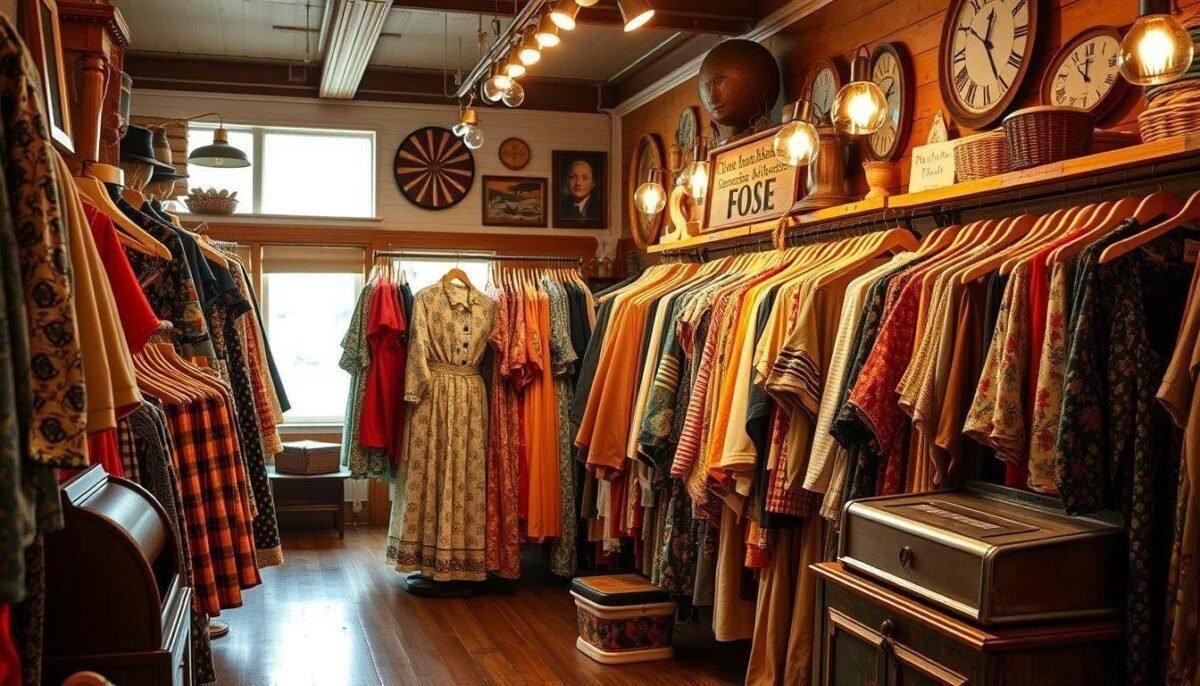Did you know 60% of Americans have shopped at thrift stores? Advice for the Thrift Store Addict Some people find it hard to stop. If you’re looking for help because you can’t stop going to thrift stores, you’re not alone. There are tips that can help you manage this habit.
Recognizing the signs of thrift store addiction is key. If you’re addicted, finding support is vital. Any advice on thrift shopping can help you have a healthier relationship with it. Secondhand shopping addiction can really affect your life, so it’s important to find ways to stop.

Understanding why you’re addicted to thrift stores is the first step. Then, using effective tips can help you control your shopping. This guide will give you a detailed plan to beat secondhand shopping addiction. It offers practical advice and support for a more mindful approach to thrift shopping.
Understanding Your Thrift Store Addiction: Signs and Triggers
Recognizing the signs of thrift store addiction is the first step towards seeking help and gaining control. If you constantly think about your next thrift store visit or feel anxious when you can’t go, it may be a sign of addiction. To control thrift store addiction, it’s essential to understand the emotional triggers behind your behavior.
Some common signs of thrift store addiction include compulsive buying, emotional attachment to purchases, and the impact on personal space and finances. For instance, if your closet is full of clothes from thrift stores but you never wear them, it may be a sign that you need thrift store addiction help. Finding the best thrift store finds can be exciting, but it’s important to balance the thrill of the hunt with responsible shopping habits.
Emotional triggers such as the desire for sustainability, nostalgia, or the thrill of the hunt can drive excessive thrifting. Understanding these triggers can help you develop strategies to manage your addiction and make more mindful purchasing decisions. By acknowledging the signs and triggers of thrift store addiction, you can take the first step towards seeking help and developing a healthier relationship with thrift shopping.
To better understand your thrift store addiction, consider the following signs and triggers:
- Compulsive buying: Do you find yourself buying items you don’t need or can’t afford?
- Emotional attachment: Are you emotionally attached to your thrift store purchases?
- Impact on space and finances: Is your thrift store addiction affecting your living space or finances?
By recognizing these signs and triggers, you can begin to address your addiction and seek help. Remember, seeking help is the first step towards developing a healthier relationship with thrift shopping and maintaining a balanced lifestyle.
I’m Addicted to Thrift Stores: Any Advice for Breaking Free?
To break free from thrift store addiction, you need self-awareness, discipline, and smart shopping habits. First, figure out why you shop so much and find ways to handle those feelings. This might mean setting a budget, trying new hobbies, or being mindful while shopping.
Adopting sustainable shopping habits can help. Look for ways to save money, like shopping during sales or using coupons. Buying second-hand is also a good choice. Think about how your shopping affects the environment and choose eco-friendly options when you can.
Here are some steps to overcome thrift store addiction:
- Set clear shopping limits and stick to them
- Make a shopping list to only buy what you need
- Try new hobbies to replace thrift shopping time
By following these tips, you can stop excessive thrifting and have a healthier shopping habit. It’s about finding a balance and being thoughtful about what you buy.

With effort, you can beat your thrift store addiction and shop more sustainably. Begin with small changes, like shopping less or trying new hobbies. Gradually move towards a more balanced and mindful way of shopping.
Creating a Mindful Thrifting Strategy
Developing a mindful approach to thrift shopping can help individuals make more intentional purchasing decisions. By setting a budget and creating a pre-shopping checklist, individuals can avoid impulse buys. This helps them stay focused on their needs.
One effective way to practice mindful thrifting is to implement the 24-hour rule. This involves waiting 24 hours before purchasing an item. It ensures the item is truly needed or wanted. This strategy can help individuals overcome vintage shopping addiction and develop a healthier relationship with thrift shopping.
For those seeking vintage shopping addiction support, creating a mindful thrifting strategy is key. By being more intentional with purchases and practicing patience, individuals can transform their thrift shopping experience. Some key strategies to consider include:
- Setting clear shopping boundaries
- Developing a pre-shopping checklist
- Implementing the 24-hour rule
By incorporating these strategies into their thrift shopping routine, individuals can develop a more mindful and intentional approach to shopping. This can help them stay within their budget, avoid clutter, and find more joy in the thrift shopping experience.
| Strategy | Benefits |
|---|---|
| Setting clear shopping boundaries | Helps avoid impulse buys and stay focused on needs |
| Developing a pre-shopping checklist | Ensures needs are met before wants and helps stay organized |
| Implementing the 24-hour rule | Helps overcome impulse buys and develop a healthier relationship with thrift shopping |
Financial Wellness Through Controlled Thrifting
Financial wellness is key to beating thrift store addiction. It’s important to know how to control it and get help. By setting a budget and tracking expenses, you can shop thriftily.
Some key strategies for financial wellness include:
- Creating a budget that accounts for thrift shopping expenses
- Setting a spending limit for each thrift shopping trip
- Avoiding impulse purchases and sticking to a shopping list
By focusing on financial wellness, you can overcome thrift store addiction’s financial strain. This is done by getting help and learning to control your spending. With the right approach, you can enjoy thrift shopping without harming your finances.
Working towards financial wellness brings many benefits, such as:
- Reduced debt
- Increased savings
- Improved financial security

By managing your finances and getting help for thrift store addiction, you can have a healthier relationship with thrift shopping. This leads to a more balanced and fulfilling life, free from addiction’s negative effects.
| Strategy | Benefit |
|---|---|
| Creating a budget | Reduces financial stress |
| Setting a spending limit | Prevents overspending |
| Avoiding impulse purchases | Increases savings |
Conclusion: Building a Healthier Relationship with Thrift Shopping
Starting a healthier relationship with thrift shopping takes time and patience. The tips in this article can change how you shop. They help you shop more mindfully and save money.
Setting boundaries and using a checklist can help you avoid overspending. Focus on items that make you happy and fit your style. This way, you only bring home what you truly need.
Shopping thrift can clear your space and mind. It lets you enjoy the thrill of finding great deals. Remember, it’s a journey. With effort and kindness to yourself, you can make thrift shopping a positive part of your life.
FAQ
Q: How do I know if I’m addicted to thrift stores?
A: Signs of thrift store addiction include compulsive shopping and an urge to visit thrift stores. You might feel emotionally attached to your finds. If it affects your daily life, it’s time to seek help.
Q: What are the emotional triggers behind my thrift store addiction?
A: Thrift store addiction can be triggered by the thrill of finding unique items. You might also feel nostalgic or want to be sustainable. Recognizing these triggers helps you find better ways to cope.
Q: How can I break free from my thrift store addiction?
A: To overcome thrift store addiction, set shopping limits and practice mindfulness. Look for affordable alternatives. Understanding and addressing emotional factors is key, and don’t hesitate to seek support.
Q: What are some tips for developing a more mindful thrifting strategy?
A: For mindful thrifting, start with a budget and a pre-shopping checklist. The 24-hour rule helps avoid impulse buys. These steps help you make thoughtful choices and enhance your thrift shopping experience.
Q: How can I improve my financial wellness while thrift shopping?
A: To improve your finances while thrift shopping, budget and track your spending. Make choices that are good for your wallet. This way, you can enjoy thrift shopping without financial stress.

1 thought on “Advice for the Thrift Store Addict: Tips to Curb the Habit”